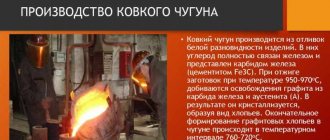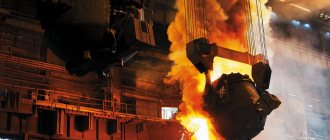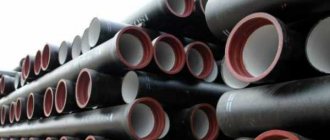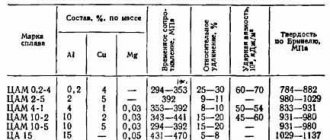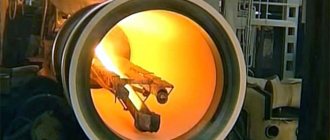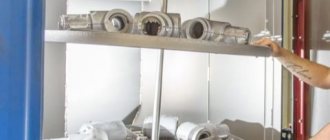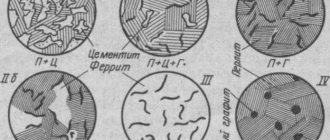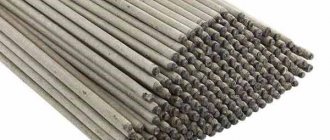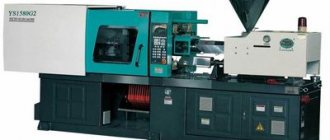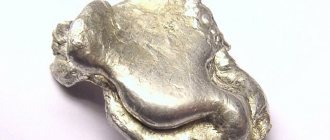Iron casting technology
The technology of cast iron casting was first mastered in China around the 10th century AD; in Europe it was first mentioned in the 14th century as a material for the production of cannons. In Russia, the first “iron casting suitable for making cannons” dates back to the era of Ivan IV Rurikovich. The heyday of the cast iron era came in the 19th and 20th centuries. At this time, bridges and pipelines, lanterns and fences, elements of architectural decor and load-bearing structures of buildings were made from it. In addition, rails, parts of machine tools, and engines were cast from the same material. Separately, it is worth mentioning cast iron cookware, irons and heating appliances.
Cast iron was also the starting component for the production of steel using the open-hearth method. The volume of its production was the most important indicator of the country's economic power and its military potential. With the invention of inexpensive technologies for the production and processing of aluminum and steel alloys, the importance of cast iron as a structural material has noticeably decreased. The widespread development of the production of high-strength plastics and composite materials has finally pushed cast iron from the forefront.
Iron casting process
Cast iron is produced in blast furnaces - huge structures as high as a ten-story building. After the ore is melted and impurities are removed, the cast iron is cast into steel molds - molds. The resulting ingots (pigs) contain cast iron of a certain grade and are ready for further processing. At foundries, various finished products are cast from them.
Iron casting process
The main stages of the iron casting process:
- Preparing a finished product model
- Making a mold for casting
- Melting cast iron pigs
- Melt casting into molds
- Removing castings and finishing them
There are several methods for making models and preparing molds
Interior design and architecture
Kasli casting is one of the types of folk crafts for the production of many varieties of artistic products from cast iron. This type of art received its name due to the location of the foundry production facilities for their manufacture. This is an architectural and artistic casting plant located in the city of Kasli, which is part of the administrative structure of the Chelyabinsk region.
Types of Kasli products
Among the many cast iron products made using the Kasli casting technique, the following types can be distinguished:
- Cast iron sculptures.
- Products of decorative and applied arts.
- Items for decorating architectural structures.
Kasli cast iron products are characterized by high decorativeness and elegance of lines, despite the fact that they are made from such a specific material as cast iron. After all, we are all accustomed to the fact that cast iron products, as a rule, should be clumsy and bulky. But Kasli products completely refute this idea - and sometimes you can’t even believe that they are really made of cast iron.
Cast iron sculpture "Zaporozhye Cossack and fortune teller"
History of the fishery
Today, the history of the emergence and development of Kasli casting goes back more than two and a half centuries. In the middle of the 18th century (1747) an “iron-making and iron-smelting plant” was founded in Kasli, the founder of which was the wealthy merchant Yakov Korobkov.
The location for the new plant was not chosen by chance - it was in Kasli that there was a large deposit of a unique natural raw material - high-quality molding sand. In addition, in the vicinity of the town there was a huge amount of wood for heating and maintaining the required temperature in blast furnaces.
Four years after the founding of the plant, the enterprise became the property of the Demidovs. By this time, the high-quality cast iron products of the Kasli plant had already become widely known in many European and Asian countries. The enterprise brought considerable profit to its owners, especially since all the raw materials for the production of cast iron products were mined almost locally, and its cost was pennies.
Cast iron bust of Alexander Suvorov
However, later the Demidovs still sold the plant to the merchant Lev Rastorguev, who significantly increased the volume of cast iron production. Already in the first decade of the 19th century, many talented Russian molders and minters worked at the Kasli plant, as well as famous sculptors of that period - graduates of the St. Petersburg Academy of Arts M. D. Kanaev and N. R. Bach. Thanks to their efforts, over time, the plant opened its own art school, which trained new craftsmen, teaching them the art of artistic casting.
The work process of Kasli masters at the beginning of the 20th century
Thus, the quality of cast iron products gradually improved, and at the same time the fame of the Kasli plant grew throughout the world. In the mid-19th century, cast iron products made at the Kasli factory received a Small Gold Medal at an exhibition in London and Paris. Needless to say, this was an extremely important and significant event in the history of the plant, and the position of its products on the world market was significantly strengthened.
Sculpture “Horse in a Hedge” (1860)
At the end of the 19th century, in 1896, an All-Russian exhibition was held in Nizhny Novgorod, at which the products of Kasli craftsmen were presented in an amazingly beautiful openwork pavilion made using iron casting techniques.
Cast iron pavilion at the exhibition (1896)
A unique decoration of the pavilion was the cast iron sculpture "Russia" , depicting a woman warrior with a shield in her hands - the work of sculptor N. A. Laveretsky. In this case, the article was a symbol of the country, and representatives of the plant flatly refused to sell it to interested buyers, despite the high price offered.
N. A. Laveretsky. Sculpture "Russia" (1896)
Then there was an exhibition in Paris (1900), where the Kasli plant presented a huge pavilion in the form of a Byzantine-style palace, made of cast iron.
Cast iron pavilion in Byzantine style (1900 exhibition)
However, the triumph was followed by a series of difficult years for the Kasli plant. Thus, his work was negatively affected by the First World War, then the October Revolution and the Civil War. The Great Patriotic War also caused considerable damage to the plant - the production of artistic products made of cast iron was suspended and many secrets of craftsmanship were lost.
And only 12 years after the end of the Second World War, a gradual and painstaking restoration of the plant’s production capacity began. Later the production of art products was resumed.
Sculptural portrait of A. S. Pushkin
Manufacturing technology of cast iron products
The main characteristic features of the artistic cast iron products of the Kasli plant developed back in the 19th century, during the heyday and worldwide fame of the enterprise. Among the features of cast iron products are the following:
- Graphic clarity and strict silhouette lines.
- Sculptural precision of elements and careful work on every detail of the product.
- Fixed planes and the play of reflections on the fractures of products.
- A special paint formulation for coating finished cast iron products, which is called “Dutch carbon black”.
During the operation of the plant, many famous sculptors worked and created there: E. A. Lanceray, P. K. Klodt, P. - J. Mene, N. A. Laveretsky, R. I. Bach and O. Taezhnaya.
E. Lanceray. Sculpture "Circassian and a woman on a horse."
Today, a collection of unique works of iron casting is presented in the Museum of Fine Arts in Yekaterinburg and in the museum of the plant itself in the city of Kasli.
Cast iron sculpture "Prisoner of the Caucasus"
Basic methods of iron casting
Modern industry uses many different methods to produce iron castings. They come down to several basic casting methods:
- into molds made from a clay-sand mixture (the so-called “in-ground” casting)
A model of the finished product is placed inside the mold, completely repeating its shape, but exceeding it in size by the amount of casting shrinkage. The clay-sand mixture is compacted and compacted, ensuring complete adherence to the model. Casting of cast iron into a mold is carried out through specially provided holes - sprues.
- into plaster molds (and from other hardening solutions);
- into shell forms;
- in chill molds (metal protected forms);
- by lost wax models;
- under pressure.
- In a gasified model
Experts distinguish several types of cast iron, depending on the content of certain impurities.
Gray cast iron contains from 2.9% to 3.7% graphite and silicon, has excellent casting properties:
- low melting point
- high melt fluidity
- small shrinkage.
It is a suitable material for machine bodies and mechanisms, pistons and engine cylinder blocks. High fragility precludes the use of the material in parts subject to bending and tension. Casting of gray cast iron is mainly carried out in sand molds and in chill molds.
High-strength cast iron, ductile iron, contains graphite in spherical form. This type of graphite is characterized by high viscosity and malleability, suitable for forging. Pipes, pipeline fittings, critical and highly loaded mechanical parts are cast from it.
Products made from high-strength cast iron are also produced by casting into a gasified model. Cast iron is cast into a mold made from a sand mixture compacted around polystyrene model blocks.
To improve the mechanical properties, high-strength cast iron castings are subjected to heat treatment. Its main stages:
- heating up to 850 °C;
- exposure in a heated state for several hours;
- slow cooling in mineral oil at 350 °C.
Read also: Regulator relay diagram 1213702
Heat treatment increases the homogeneity of the material and relieves internal stresses in the casting, reducing the likelihood of cracks during operation
Shell casting
This method, like the previous ones, is a method of casting into one-time molds. To produce thin shell molds, you need 20-30 times less molding materials than for sand or LCS molds. The method is used for cast iron, steel and aluminum castings of simple configuration without internal cavities in mass production.
Casting into shell molds, which are made from molding mixtures (quartz sand with thermosetting binder resin) using hot models.
Pulverbakelite is used as a binder for the manufacture of shell molds. –
a mixture of phenol-formaldehyde resin SFP-011L with 7% methenamine.
Urotropin
used as a hardening accelerator. Low toxicity, classified as hazard class 3, MPC – 9 mg/m3 (GOST 1381-73).
Currently, no alternative to phenol-formaldehyde-based thermosetting resins for the manufacture of shell molds has been found in terms of manufacturability and surface quality of the molds.
The method ensures surface roughness Rz = 80...40 μm, and accuracy - 12...14 quality. The method can be easily mechanized and automated.
Iron production
From a number of the main indicators of the country's economic power, the production of cast iron was relegated to a number of secondary ones, but did not lose its importance for the economy.
The leader in pig iron production with an almost tenfold lead is China - 543.748 million tons per year, followed by Japan - 66.943 million tons, Russia - 43.945 million tons and India - 29.646 million tons. China produces more than 50% of the world's pig iron.
Cast iron is produced in blast furnaces, the prepared iron ore is smelted along with additives, and coking coal or natural gas is used as fuel.
The main consumption of pig iron today is as a component for steel smelting. The development of cast iron production is mainly in the direction of increasing its energy efficiency, environmental friendliness and cost reduction.
The unique properties of cast iron - low cost, strength and corrosion resistance - allow the ferrous metal to look confidently into the future.
Types of cast iron
The optimal combination of technological and operational properties of this multicomponent alloy explains its wide distribution in various industries. The properties of cast iron depend on the structure of the main mass, the number and location of graphite inclusions. Taking these parameters into account, the material is classified according to GOST 2443-77. Moreover, all characteristics are assessed on special scales. According to the classification, the following types of cast iron are distinguished:
- grey;
- high strength;
- malleable;
- antifriction;
- alloy.
Among them, the best casting alloy is gray. A wide variety of castings are obtained from it, and with the highest yield of suitable castings. High-strength material with spherical graphite also has good properties. It made it possible to reduce the weight of structures while maintaining reliability and durability.
But still, the main composition for iron casting is bayonet cast iron, produced in blast furnaces. Along with it, return, ferroalloys, as well as steel scrap are usually sent to the smelter to improve the mechanical properties of castings.
Cast iron castings
Cast iron castings come in different sizes - from small parts to multi-meter beds of large machine tools. Their configuration can also be very diverse - from simple bushings to sophisticated cast grilles and gates.
Iron castings are also divided into:
- by purpose - general and special, such as anti-friction, heat-resistant, etc.
- according to the structure of the material - ferritic, perritic and mixed
- According to the type of graphite contained - into spherical, lamellar, flake and vermicular
- According to carbon content - white, gray and bleached
In metallurgical science, there are other classifications of cast iron castings.
Casting methods
The most modern method is casting using gasified models. This method allows not only casting iron, but also producing steel castings. The method is economical, environmentally friendly and allows for the reuse of mold material.
The method consists of the following steps.
Model preparation
The models are made from pre-foamed and dried polystyrene with a grain size of 0.3-0.9 mm. (depending on the dimensions of the part). The material is blown into molds, baked and cooled.
Casting using gasified models
Models are glued or soldered into blocks. Next, the blocks are lowered into the bath to apply a non-stick coating and dried. If the product configuration is complex, then the coating is applied from a nozzle.
Molding
Model blocks are placed in a flask placed on a vibrating base, gradually filling them with a sand-clay mixture, their “earth”. Sometimes backfilling is done layer by layer, compacting each separately.
The filled and compacted molds are transported to the pouring shop. The vacuum pump completes the compaction of the sand and gives it sufficient strength.
Pouring metal
The metal is poured directly into the model material. The liquid melt evaporates the polystyrene models and fills all the relief details.
Polystyrene combustion products are removed by a vacuum pump directly through the walls of the mold.
Final operations
Iron castings cool in the mold. The rate of temperature decrease and its overall duration are determined by the weight of the part, the thickness of its walls and the requirements of the production process. Next, the molds are broken, the castings are cleaned of remnants of non-stick paint, and the sprues are removed.
Advantages of cast iron
Iron casting differs from castings from other materials in a number of advantages, such as:
- cheapness
- high strength and wear resistance
- high surface quality, minimizing subsequent machining
Characteristics and application of cast iron
It is important to note that when using modern casting methods, not only the casting itself is cheaper, but also the final product. Many industries, which at the end of the 20th century replaced the cast iron parts of their products with steel ones, have returned or are planning to return to the time-tested material at a new stage of its development.
If you find an error, please select a piece of text and press Ctrl+Enter.
Most machines and various types of structures that are widely used on Earth are made of metals. And a special place among them is occupied by ferrous metals, which mainly include iron and its alloys.
Read also: Free copper
Cast iron is “the most foundry metal.” The share of cast iron castings in mechanical engineering ranges from 40 to 80%.
Cast irons are iron-carbon alloys with a carbon content of more than 2.14%, which have a eutectic component, graphite or ledeburite eutectic, in their structure.
About three-quarters of all castings are made from cast iron: gray, alloy, ductile and high-strength. The most common is gray cast iron.
Cast iron has a number of significant advantages over steel. These include better fillability of casting molds, lower volumetric shrinkage, and, most importantly, low smelting costs.
Liteika.ru is the flagship of the Russian iron foundry. For 30 years, we have been casting custom-made cast iron castings with improved physical and mechanical properties.
Main directions
Casting chromium cast iron ChH, IChH
- Parts and devices made by wear-resistant casting of chromium cast iron are used in industry where interaction with nitrogen occurs, or in the production of pumps and other mechanisms.
- Casting chromium cast iron ChH, IChH is used for the manufacture of grates, furnace blades, ridges and other components for furnaces, since they are resistant to high temperatures.
- Suitable for the production of blades, armor and other parts for mechanisms.
- We make custom-made special vessels for transporting abrasive and aggressive masses.
Wear-resistant castings made of chromium cast iron alloys (ICHH, CHH) are characterized by high strength. Products made from ICH are practically resistant to mechanical damage during operation and can withstand high temperatures up to 1000-11000 C.
Chromium cast irons are alloyed with chromium, nickel or silicon, so they are classified as special-purpose cast irons. The increased wear resistance of the products makes it possible to operate products made from ICH and CHH in aggressive environments and at temperatures up to 11,000 C.
LITTECH LLC performs casting of chromium cast iron from wear-resistant alloys, intended for completing industrial products. In production we use our own specially developed alloys of HF and ICHH. We develop, design and manufacture products according to customer drawings and equipment.
The production capacity of LMZ LITTECH LLC is designed to produce large quantities of products, therefore we fulfill and deliver orders on time.
General properties of cast iron
Cast iron is produced in blast furnaces. The heating temperature from burning gas and coal dust increases. As a result, 2 types of high-carbon alloys are obtained:
Particle alloy, mostly white, very hard. It contains carbon in a bound form; the grain is white at the fracture. Very hard, cannot be processed with cutting tools. It is used as the main raw material for the production of steels of various grades.
Other types of cast iron: gray, malleable, high-strength. They have high fluidity and are used for the manufacture of parts by casting into molds followed by cutting. The hardness is significantly higher than that of non-hardened steels. High abrasion resistance. Disadvantages include fragility, low resistance to bending and torsion.
Cast iron is called malleable for its relatively high ductility and resistance to dynamic loads. It is stronger than gray due to the compact flake-like inclusions of graphite located between the grains. In a high-strength alloy, graphite has a spherical shape. Other types of cast iron contain free carbon in the form of graphite plates along the grain boundaries and break relatively easily. In fact, no type of cast iron can be forged.
When processing cast iron by cutting at low feed and speed, a surface with high cleanliness is obtained. Dimensions accurate to 0.02 mm.
Iron production
When starting a blast furnace, coke and sinter - enriched iron ore with flux - are poured into it layer by layer. Oxygen, a heated gas, is injected from below through the nozzles. During the combustion of coal, it is chemically converted into carbon dioxide CO2, then into oxide CO, which oxidizes iron, releasing it from the ore and making it solid.
The blast furnace process is continuous. Ore and flux are added regularly. When a certain amount of cast iron has accumulated, it is released into a ladle and then poured into molds. Liquid slag prevents oxidation of the molten metal. It is drained after the cast iron through a tap hole located above and taken outside the workshop. Later they are used as a raw material for cement production and in construction.
Advantages of cast iron
Making parts from cast iron costs much less than making similar products from steel or bronze. The increased phosphorus content makes cast iron fluid. It easily fills all voids in the form, including small elements. In terms of beauty and variety, cast iron grates look better than forged ones. They are resistant to moisture and do not require regular maintenance.
Read also: PPU insulation what is it
Cast iron has a variety of shapes, can be in water and soil for a long time, and is resistant to low temperatures. The production of pipes and fittings, couplings, and valves has a simple technology compared to other materials.
There is virtually no shrinkage of cast iron during cooling. This allows you to make castings with minimal waste: small profits, without storage. Processing of parts is reduced to turning the seats.
Cast iron bushings are placed in plain bearings on low-speed shafts. Having high wear resistance by abrasion, they last longer than ball bearings and cost several times less.
Iron casting technology
Cast iron is cast in a strict sequence:
- loading the charge,
- continuous smelting process in a blast furnace,
- pouring finished cast iron into a ladle,
- pouring into prepared molds,
- cooling,
- annealing,
- descaling.
Centrifugal casting is used in the manufacture of pipes and hollow parts. In this method, cast iron is poured into a rapidly rotating mold. Under the influence of centrifugal force, liquid metal spreads over the surface to a given thickness.
The remaining parts are poured into the ground according to a pre-made mold.
Where to order cast iron?
Services for the production of custom-made iron castings in Moscow and the Moscow region are offered by ZAO Mayak Special Machine Building Plant. Available production capabilities allow us to produce castings weighing up to 40 tons. In this case, various cast iron alloys are used to make castings. Also among the advantages of cooperation with JSC “Special Machine Building Plant “Mayak”:
- quality guarantees of manufactured products (all products comply with GOST requirements and undergo laboratory tests);
- the use of various technologies depending on the customer’s needs;
- minimum production time;
- professionalism and significant work experience, allowing you to solve problems of any level of complexity;
- favorable pricing policy.
Any questions? Employees of ZAO Special Machine Building Plant Mayak are ready to advise on all aspects of ordering castings.
Iron casting process
When a sufficient amount of liquid metal accumulates in the lower part of the furnace, a tap hole is punched, and the red-hot mass is poured into the ladle, from which the cast iron is directly cast into molds. The pouring tool is a ladle with a hole at the bottom with a plug. Small parts are poured through it. For large, heavy castings, when you need to quickly fill the mold, you can use the spout at the top of the ladle, tilting it with a crane.
Model preparation
Models are made from various materials. Wood is used to produce small batches and single blanks of large parts. The model repeats the external shape of the part with allowances for shrinkage. Rods from the molding mixture are inserted into the locations of the holes.
The following materials are used for making models:
To produce large batches of castings, starting from several hundred, with complex configurations, models made of bronze, brass, and aluminum alloys are used, made on CNC machines and other equipment. The result is a casting with great accuracy of external dimensions, which does not require processing.
Molding
The model is inserted into a metal mold, and the remaining space is filled with a sand-clay mixture. To obtain a dense shell, the mixture is compacted on vibration stands or compacted with hand-held pneumatic tools.
Large forms are filled in several stages, adding the mixture. The model is then removed. The surface of the mold is treated with a non-stick compound and dried.
Pouring metal
The forms are placed in one row in a specially prepared place. The sprues for pouring are installed above them. The ladle starts over the molds and quickly fills them. If cast iron is poured for a long time, the castings will cool unevenly, and metal delaminations may form inside.
Final operations
After pouring, the molds remain in the pit to cool evenly for 12–60 hours. The duration of the process depends on the largest cross-section of the casting.
The cooled mold is taken out, the part is freed from the molding sand and, together with the accumulators and profits, is placed in a thermal furnace for annealing. The metal is heated to 800⁰–900⁰, depending on the mass of the casting and the grade of cast iron. Then it is kept at a given temperature for several hours. The cast iron, together with the stove, slowly cools down to 300⁰. Then the casting is removed and cooling continues in air.
After annealing, the structure of cast iron is leveled and stress is relieved. Now the technological extensions and other elements are cut off. The surface is cleaned from molding sand residues and scale.
